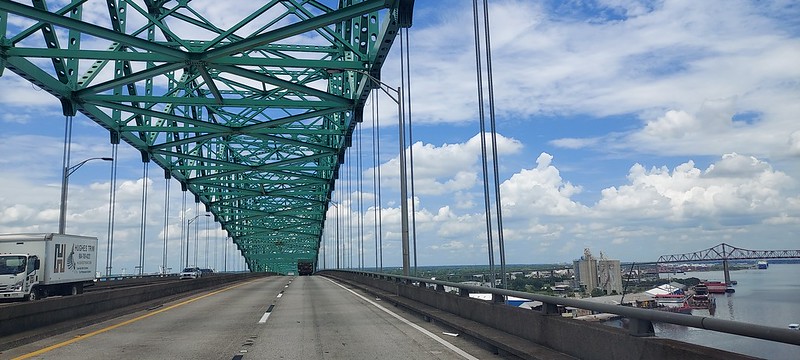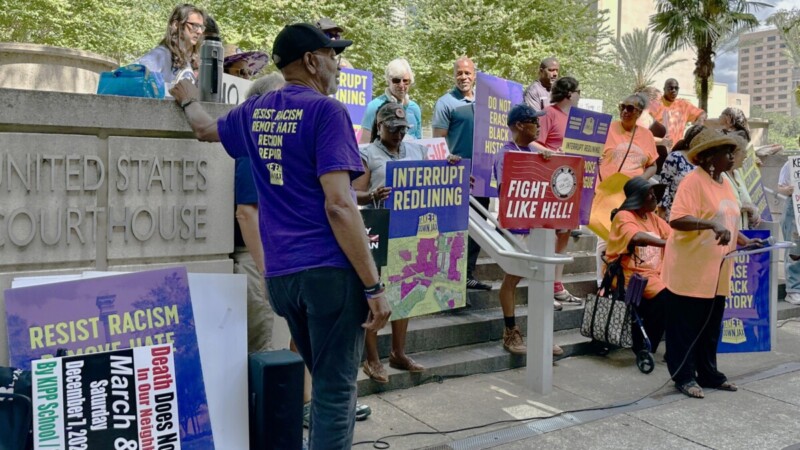
Consuming nearly 800 square miles of land area, the city of Jacksonville contains more expressways than any other city in the state. Here are a few you may not have heard of, despite being one of the thousands who drive on them everyday.
Acosta Expressway

The Acosta Expressway serves as a connection between the Acosta Bridge and I-95. The original bridge was built in 1921, making it the first automobile and only streetcar crossing over the St. Johns River in Jacksonville. It was named for City Council member St. Elmo W. Acosta, who was instrumental in its funding. A lift span, similar to the Main Street Bridge, it was called the “Yellow Monster.”
In 1994, it was replaced by today’s 1.1-mile-long Acosta Bridge and elevated expressway. The six-lane bridge, also labeled State Road 13, includes the JTA Skyway in its median, making it the only river crossing in the city with dedicated mass transit infrastructure.
Commodore Point Expressway

Now known as the Hart Bridge Expressway and State Road 228, this structure was originally called the Commodore Point Bridge and Expressway. Completed in 1967, it was originally intended to connect the Haines Street Expressway, now MLK, Jr. Parkway, with Jacksonville Beach. Where the Hart Bridge crosses the St. Johns River has been historically called Commodore Point. Commodore Point was a part of a 225-acre Spanish land grant to Daniel Hogans. It was an area where several sawmills and wharves, which used enslaved labor, operated prior to the Civil War. Southside opposition ultimately resulted in the expressway’s terminating at Beach Boulevard, a few miles west of Southside Boulevard.
Emerson Street Expressway

Completed in 1967, the Emerson Street Expressway was built as a short spur of the Commodore Point Expressway to connect Hart Bridge traffic with Emerson Street on Jacksonville’s Southside. This 0.930-mile-long freeway includes an interchange at Beach Boulevard and is also known as State Road 228A.
Hart Bridge Expressway

The Hart Bridge Expressway, or State Road 115A, connects the Haines Street Expressway on Jacksonville’s historic Eastside to Commodore Point. Carving through an area of the Eastside known as Fairfield, it is named after the founder of Jacksonville, Isaiah Hart, and is anchored by the Isaiah David Hart Bridge, sometimes called the “Green Monster.”
Roosevelt Expressway

Completed in 1960 and named in honor of President Franklin D. Roosevelt, the Roosevelt Expressway is on Jacksonville’s Westside. Originally built as a spur to I-10, to allow heavy U.S. 17 automobile and truck volumes to bypass the historic neighborhoods of Riverside and Avondale, the expressway connects I-10 with Blanding Boulevard. Partially built to freeway standards, the expressway includes interchanges at Blanding Boulevard, Edgewood Avenue and I-10 and includes signalized intersections at McDuff Avenue and Plymouth Street. Today, its known as being a part of Roosevelt Boulevard.
Union Street Expressway

Built between 1952 and 1953, the Union Street Expressway was the first expressway segment built in Jacksonville. Connecting Union and State streets with the Mathews Bridge, it includes interchanges at A. Philip Randolph Boulevard and MLK, Jr. Parkway. Hundreds of residences and businesses were destroyed as the expressway’s path ripped through the Historic Eastside community, severing its link between residents and the Downtown riverfront. As Arlington has developed over the decades, this small stretch of highway is generally recognized as being the western leg of the Arlington Expressway.






